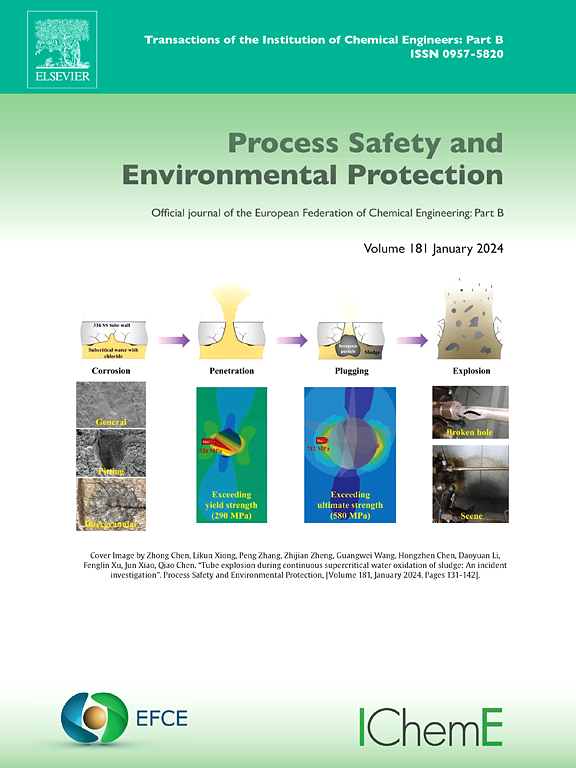一种从熔盐氯化渣中回收氯化钠并将其再循环到氯化钛生产熔盐过程中的新方法——基于相图分析
IF 7.8
2区 环境科学与生态学
Q1 ENGINEERING, CHEMICAL
引用次数: 0
摘要
TiCl4是生产高端钛材料的重要中间体。熔盐氯化法是目前国内生产钛白粉的主要方法。但在此过程中会产生大量的熔盐氯化残渣(MSCR)。复杂的残留物难以处理,造成严重的环境问题。为了减少熔融盐氯化过程中MSCR对环境的污染和NaCl的循环利用,提出了一种从MSCR中回收气态NaCl的相变新工艺。CaCl2和MgCl2是阻碍NaCl回收的主要杂质。因此,本文系统地研究了CaCl2和MgCl2的影响机理以及对NaCl回收率的提高,包括热力学相图分析、Na2SiO3添加剂和温度的影响。结果表明,随着NaCl活性的增加,抑制了硅酸镁钠和硅酸钙钠的生成,提高了NaCl的回收率。在1200℃条件下,当n(CaCl2+MgCl2): n(Na2SiO3) = 1:1时,NaCl的回收率为94.36 %,产物中NaCl的含量为99.96 %。该方法成功地实现了MSCR的无害化处理和氯化钠的回收。本文章由计算机程序翻译,如有差异,请以英文原文为准。
A novel method to recover NaCl from molten salt chlorination residue and recycle NaCl back into molten salt chlorination process in TiCl4 production: Based on phase diagrams analysis
TiCl4 is the significant intermediate to produce high-end titanium materials. Molten salt chlorination is the main way to produce TiCl4 in China. However, there is a large amount of molten salt chlorination residue (MSCR) produced during this process. The complex residue is difficult to be treated, causing serious environmental problems. To reduce environmental pollution associated with MSCR and recycle NaCl in the molten salt chlorination process, a novel process of phase transition to recover gaseous NaCl from MSCR was proposed. CaCl2 and MgCl2 are the dominant impurities to hinder the recovery of NaCl. Thus, the influence mechanism of CaCl2 and MgCl2 and improvements in the recovery of NaCl were systematically investigated in this work, including the thermodynamic phase diagrams analyses, the effects of additive of Na2SiO3 and temperature. As a result, sodium magnesium silicate and sodium calcium silicate were prohibited to generate and the recovery efficiency of NaCl was promoted along with the increasing activity of NaCl. The recovery efficiency of NaCl is 94.36 % and the content of NaCl in the gaseous product is 99.96 % at 1200℃ when n(CaCl2+MgCl2): n(Na2SiO3) = 1:1. This method successfully realizes the harmless treatment of MSCR and the recovery of sodium chloride.
求助全文
通过发布文献求助,成功后即可免费获取论文全文。
去求助
来源期刊

Process Safety and Environmental Protection
环境科学-工程:化工
CiteScore
11.40
自引率
15.40%
发文量
929
审稿时长
8.0 months
期刊介绍:
The Process Safety and Environmental Protection (PSEP) journal is a leading international publication that focuses on the publication of high-quality, original research papers in the field of engineering, specifically those related to the safety of industrial processes and environmental protection. The journal encourages submissions that present new developments in safety and environmental aspects, particularly those that show how research findings can be applied in process engineering design and practice.
PSEP is particularly interested in research that brings fresh perspectives to established engineering principles, identifies unsolved problems, or suggests directions for future research. The journal also values contributions that push the boundaries of traditional engineering and welcomes multidisciplinary papers.
PSEP's articles are abstracted and indexed by a range of databases and services, which helps to ensure that the journal's research is accessible and recognized in the academic and professional communities. These databases include ANTE, Chemical Abstracts, Chemical Hazards in Industry, Current Contents, Elsevier Engineering Information database, Pascal Francis, Web of Science, Scopus, Engineering Information Database EnCompass LIT (Elsevier), and INSPEC. This wide coverage facilitates the dissemination of the journal's content to a global audience interested in process safety and environmental engineering.
 求助内容:
求助内容: 应助结果提醒方式:
应助结果提醒方式:


